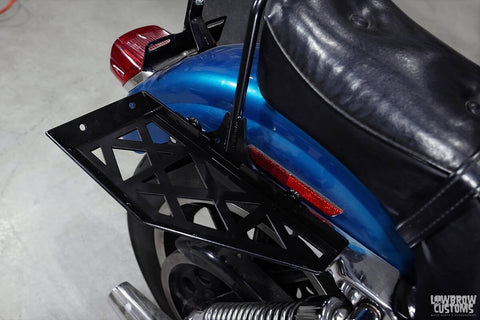In this DIY Tech Tip from Lowbrow Customs, Todd shows you how to test your motorcycle's cylinder compression, and what it means. A simple compression tester which is available at most any auto parts store is all that is needed for this useful task. This can help identify compression loss, which has a MAJOR effect on the engine's power, due to worn piston rings, damaged cylinder bore, leaky head gasket or work valve seats.
Check out the Lowbrow Customs YouTube channel to check out all of our videos. We spend a lot of time and effort creating motorcycle how-to videos, product reviews and event coverage for your enjoyment, please let us know what you think. Click here to subscribe to the Lowbrow Customs YouTube channel and stay in the know!
You can read a full transcription of this video below:
Hi, I'm Todd from Lowbrow Customs. Welcome to my garage. Today we're going to do a simple compression test on this 750 Triumph motorcycle. So anytime you're looking to go and buy a motorcycle that hasn't been run for a few years. It's a good idea to go ahead and get one of these simple testers available at just about any auto parts store, a simple compression tester. What this will do is tell you the condition of the rings ability to seal to the cylinder and also if the valves are sealing. This will tell you if you're ready for a top end job or not also if the motor has low compression, it probably won't even run. So it's a valuable tool when going to look to purchase a motorcycle and it does have good compression if it doesn't run, a simple test you can do to determine the status of the top end of the motorcycle.
Okay. Any motor needs four things to run. You need time ignition, which will be your spark, fuel, air and compression. So, step one you want to remove both spark plugs from both cylinders if its a twin. The compression tester that I use, a pretty old one, from Matco, it does have a quick disconnect which makes it a lot easier to thread this portion into the engine and then you can just connect this together when you're doing the test. A little think you always want to do is maybe put a little dab of grease onto the over-ring of the tester before you thread it onto the cylinder. That will help it form a good seal. There you go, some grease on there. Okay.
One other thing that I forgot to mention to is this test technically should be performed on a warm engine. But obviously if you're going to look at something that hasn't been run for a bunch of years, it doesn't run, you can't warm it up and do the test. So basically there'll be a slight variance in the results doing it cold versus warm. Here, we've got the tool threaded in into the spark plug hole, and you're just going to put this simple gauge on here. Okay, both plugs out, tool in the spark plug hole. The important thing you want to do is, you want to hold the throttle wide open when doing this test because you air to be able to get into the motor, if throttles are closed it won't let air in.
Okay, then basically you got your throttle wide open. Next thing you're going to do is you're going to kick the motor over until the needle on the gauge stops moving. Which it obviously already has. Okay on the left cylinder, I'm seeing about 60 pounds of compression psi on the left cylinder. And that is hardly enough for an engine to run. Should be over up 100 for this particular motor to probably be in the 130/140 range. There you got a little shredder valve on here, release the pressure. I'm going to go ahead and put the tool in the other cylinder. Okay now we've put the adapter into the right hand cylinder. Hold the throttle wide open, and once again kick the motor over until the gauge stops moving.
All right, now, on that cylinder we have about 65. One other important note when doing a compression test, if you do find that it does have good compression, you want the readings to be within 10% of each other. So in other words, if this-- let's say this side was 130 and this side was 140, that would be a good number. Now if you were seeing this side at 120 and this side at 140, that would tell you that you have either a problem with intake or exhaust valve sealing on this side of the engine or the rings on this side of the engine not sealing properly.
Okay, somehow we got it to run with no compression. Don't ask me how we did that but now we're going to go ahead and do another compression test with the engine warm and record the difference. Got it all hooked up to the left cylinder, throttle wide open. Okay, she came up quite a bit there between cold and hot. Now we have about 115 almost to 120. Okay, we'll go ahead and do the other side. That's all she's got on that cylinder. Good, so we're right around we're almost exactly the same as the other side.
All right, the next thing we're going to do is we're going to go ahead and squirt a little bit of motor oil down in the cylinder and through the spark plug hole. What that will tell us is, if the rings aren't sealing good, by adding some oil in the cylinder that will help the rings seal and the compression will go up. If the compression stays the same after we put the oil in, that tells you that you have a valve that's not sealing. So we're just going to put a little bit of oil down the hole. Put the tester back in there and you can see why its advantageous to have the quick disconnect and so you're not spinning the gauge around every time you're putting it in and out of the hole.
Get the throttle open. Oh, look at it going up with the oil in the hole. Looks like all she's going to go. Well, it did go up from 15 to 30. So that's a pretty good indication that the rings are worn out and not sealing to the cylinder wall. Okay, we're going to go ahead and do the same thing to the other side. A little bit of oil in the hole. Okay, we've got some oil squirt down the right hand cylinder. Through the spark plug hole, don't forget your throttle again. And that's all she wrote there. 135! Once again the compression did go up by adding the oil to the cylinder.
Okay, there you have it. Compression testing 101. Pretty simple test. Nothing complicated about that. Couple simple hand tools. Gauge available at your local house own or any other auto parts store. A non-expensive tool. Definitely will come in handy if you plan on buying these old motorcycles and bringing them home and fixing them up. If you go to look at a motorcycle and you take this with you when you go to look at it, you ask the perspective seller if they don't mind if you do a little quick compression test. It's not going to hurt anything on the bike. You do find low compression, could be a good bargaining chip as to the selling price of the motorcycle. Maybe you can get them down a few bucks, because it does not have compression. Especially on a bike that's been sitting in a garage or shed for an extended period of time not running.
Peace out.
Related Products

















